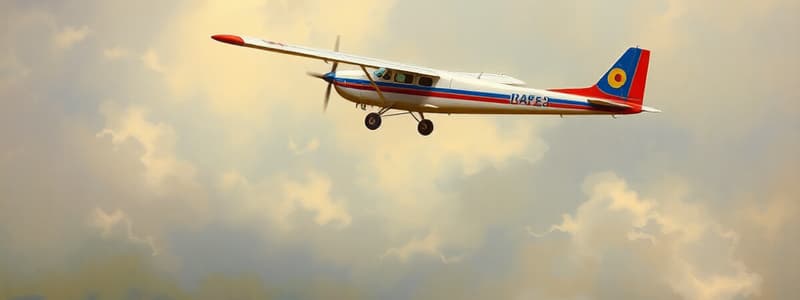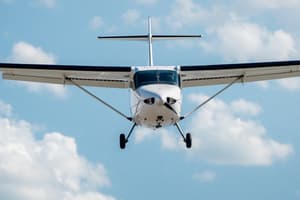Podcast
Questions and Answers
What is the minimum control speed during approach and landing commonly referred to as?
What is the minimum control speed during approach and landing commonly referred to as?
- VMU
- VMCA
- VMCG
- VMCL (correct)
Which weight limit refers to the maximum weight of the aircraft at takeoff?
Which weight limit refers to the maximum weight of the aircraft at takeoff?
- Maximum Structural Takeoff Weight (MTOW) (correct)
- Maximum Structural Landing Weight (MLW)
- Maximum Structural Zero Fuel Weight (MZFW)
- Maximum Structural Taxi Weight (MTW)
Which of the following is NOT a minimum control speed?
Which of the following is NOT a minimum control speed?
- VMCF (correct)
- VMCL
- VMCG
- VMCA
What does VMU stand for in the context of aircraft performance?
What does VMU stand for in the context of aircraft performance?
Which factor is critical in determining the environmental envelope of an aircraft?
Which factor is critical in determining the environmental envelope of an aircraft?
What does the acronym EGT refer to in engine limitations?
What does the acronym EGT refer to in engine limitations?
Which of the following does NOT typically impact thrust setting during takeoff?
Which of the following does NOT typically impact thrust setting during takeoff?
What is the primary purpose of understanding limit load factors in aviation?
What is the primary purpose of understanding limit load factors in aviation?
Which Mach number is associated with the longest range of cruise speed?
Which Mach number is associated with the longest range of cruise speed?
What is the primary factor affecting optimum cruise altitude performance?
What is the primary factor affecting optimum cruise altitude performance?
What does the Economic Mach Number (MECON) primarily aim to optimize?
What does the Economic Mach Number (MECON) primarily aim to optimize?
Which climb performance measure is defined as the vertical distance gained per unit of horizontal distance?
Which climb performance measure is defined as the vertical distance gained per unit of horizontal distance?
At a constant Mach number, what primarily determines optimum cruise altitude?
At a constant Mach number, what primarily determines optimum cruise altitude?
Which of the following is a feature of step climb optimization in cruise?
Which of the following is a feature of step climb optimization in cruise?
Which limitation primarily impacts operating maneuver performance during flight?
Which limitation primarily impacts operating maneuver performance during flight?
What is the purpose of the FCOM cruise table?
What is the purpose of the FCOM cruise table?
What is the maximum structural takeoff weight (MTOW) based on?
What is the maximum structural takeoff weight (MTOW) based on?
Which weight must comply with the equation actual LW = TOW – Trip Fuel ≤ MLW?
Which weight must comply with the equation actual LW = TOW – Trip Fuel ≤ MLW?
What is included in the calculation for Zero Fuel Weight (ZFW)?
What is included in the calculation for Zero Fuel Weight (ZFW)?
The landing weight (LW) is limited under which condition?
The landing weight (LW) is limited under which condition?
Which weight is primarily impacted by bending moments at the wing root?
Which weight is primarily impacted by bending moments at the wing root?
What is represented by the term 'Operational Empty Weight' (OEW)?
What is represented by the term 'Operational Empty Weight' (OEW)?
Which of the following is NOT included in the calculation of Takeoff Weight (TOW)?
Which of the following is NOT included in the calculation of Takeoff Weight (TOW)?
How is the Maximum Structural Landing Weight (MLW) determined?
How is the Maximum Structural Landing Weight (MLW) determined?
What is the maximum allowable VMC(A) during take-off with respect to VS?
What is the maximum allowable VMC(A) during take-off with respect to VS?
Which condition does NOT need to be met when establishing VMCL?
Which condition does NOT need to be met when establishing VMCL?
What defines VMCL in relation to engine failure during approach and landing?
What defines VMCL in relation to engine failure during approach and landing?
Which is the maximum allowed angle of bank for maintaining control after a critical engine failure at VMCL?
Which is the maximum allowed angle of bank for maintaining control after a critical engine failure at VMCL?
For aeroplanes with three or more engines, what is VMCL-2?
For aeroplanes with three or more engines, what is VMCL-2?
What is required of the aeroplane during a landing phase recovery to avoid dangerous attitudes?
What is required of the aeroplane during a landing phase recovery to avoid dangerous attitudes?
Which component is not a factor in determining VMCL according to the guidelines?
Which component is not a factor in determining VMCL according to the guidelines?
What condition must the aeroplane meet when establishing VMC(A)?
What condition must the aeroplane meet when establishing VMC(A)?
What is the relationship between VS and VS1g for JAR certified aircraft?
What is the relationship between VS and VS1g for JAR certified aircraft?
At what condition is the load factor 'n' less than 1g?
At what condition is the load factor 'n' less than 1g?
Which of the following is true regarding reference stall speed VSR?
Which of the following is true regarding reference stall speed VSR?
How is V2min calculated for aircraft models certified at VS1g?
How is V2min calculated for aircraft models certified at VS1g?
Which regulation does not reference the requirement for 1-g stall speed?
Which regulation does not reference the requirement for 1-g stall speed?
What is the term for the minimum steady flight speed at which an airplane is controllable?
What is the term for the minimum steady flight speed at which an airplane is controllable?
What was introduced in Change 15 of JAR 25 in October 2000?
What was introduced in Change 15 of JAR 25 in October 2000?
Which factor is not considered when determining VCLMAX?
Which factor is not considered when determining VCLMAX?
Flashcards are hidden until you start studying
Study Notes
Aircraft Limitations
- Aircraft limitations are physical boundaries that define an aircraft's safe operating envelope.
- Flight Limitations: Limit load factors, maximum speeds, and minimum speeds are all regulated to ensure safe operation.
- Limit Load Factors: The maximum force an aircraft structure can withstand during maneuvers, preventing exceeding structural limits.
- Maximum Speeds:
- VMO / MMO: Maximum Operating Speed / Maximum Operating Mach Number, limits exceeding the design speeds.
- Minimum Speeds:
- VMCG: Minimum Control Speed on the Ground, the minimum speed for safe control during takeoff in the event of an engine failure.
- VMCA: Minimum Control Speed in the Air, the minimum speed to maintain control after an engine failure during takeoff.
- VMCL: Minimum Control Speed During Approach and Landing, the minimum speed to maintain control in case of engine failure during approach and landing.
- VMU: Minimum Unstick Speed, the minimum speed required for the aircraft to lift off during takeoff.
- Stall Speed: The minimum speed at which an aircraft can maintain lift.
- Maximum Structural Weights:
- These weights are determined based on the structural strength of the aircraft.
- MTOW: Maximum Takeoff Weight, the maximum weight the aircraft can take off with.
- MLW: Maximum Landing Weight, the maximum weight the aircraft can land with.
- MZFW: Maximum Zero Fuel Weight, the maximum weight the aircraft can be without fuel.
- MTW: Maximum Taxi Weight, the maximum weight the aircraft can have while on the ground.
- Minimum Structural Weight: This is the minimum weight required for maintaining structural integrity, ensuring safe operation for the aircraft.
- Environmental Envelope: This encompasses factors like temperature, altitude, and atmospheric pressure, all of which affect aircraft performance.
- Engine Limitations: Determined by limitations on thrust and engine temperature.
- Thrust Setting: Limited to ensure engine operation within safe parameters.
- EGT: Engine Exhaust Gas Temperature, kept within limits to prevent overheating.
- Takeoff Thrust Limitations: Regulated to ensure safe takeoff performance.
Studying That Suits You
Use AI to generate personalized quizzes and flashcards to suit your learning preferences.




